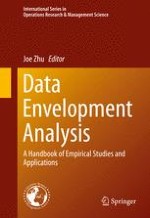2016 | OriginalPaper | Chapter
12. Applications of Data Envelopment Analysis in Education
Authors : Emmanuel Thanassoulis, Kristof De Witte, Jill Johnes, Geraint Johnes, Giannis Karagiannis, Conceição S. Portela
Published in: Data Envelopment Analysis
Publisher: Springer US
Activate our intelligent search to find suitable subject content or patents.
Select sections of text to find matching patents with Artificial Intelligence. powered by
Select sections of text to find additional relevant content using AI-assisted search. powered by
